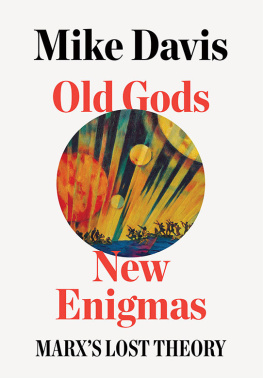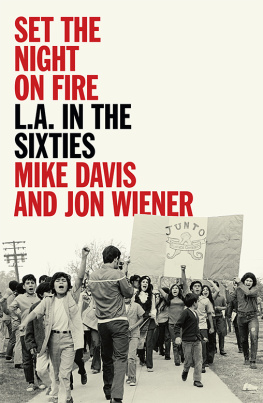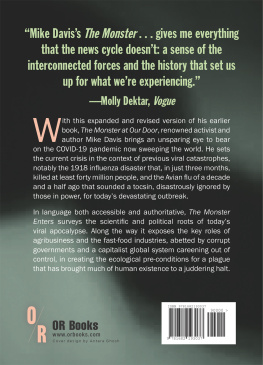Mike Davis - Planet of Slums
Here you can read online Mike Davis - Planet of Slums full text of the book (entire story) in english for free. Download pdf and epub, get meaning, cover and reviews about this ebook. City: London, New York, N.Y., year: 2007, publisher: Verso, genre: History. Description of the work, (preface) as well as reviews are available. Best literature library LitArk.com created for fans of good reading and offers a wide selection of genres:
Romance novel
Science fiction
Adventure
Detective
Science
History
Home and family
Prose
Art
Politics
Computer
Non-fiction
Religion
Business
Children
Humor
Choose a favorite category and find really read worthwhile books. Enjoy immersion in the world of imagination, feel the emotions of the characters or learn something new for yourself, make an fascinating discovery.

- Book:Planet of Slums
- Author:
- Publisher:Verso
- Genre:
- Year:2007
- City:London, New York, N.Y.
- Rating:4 / 5
- Favourites:Add to favourites
- Your mark:
- 80
- 1
- 2
- 3
- 4
- 5
Planet of Slums: summary, description and annotation
We offer to read an annotation, description, summary or preface (depends on what the author of the book "Planet of Slums" wrote himself). If you haven't found the necessary information about the book — write in the comments, we will try to find it.
Planet of Slums — read online for free the complete book (whole text) full work
Below is the text of the book, divided by pages. System saving the place of the last page read, allows you to conveniently read the book "Planet of Slums" online for free, without having to search again every time where you left off. Put a bookmark, and you can go to the page where you finished reading at any time.
Font size:
Interval:
Bookmark:
Planet of Slums


MIKE DAVIS

First published by Verso 2006
Mike Davis 2006
All rights reserved
The moral rights of the author have been asserted
1 3 5 7 9 10 8 6 4 2
Verso
UK: 6 Meard Street, London W1F 0EG
USA: 180 Varick Street, New York, NY 100144606
www.versobooks.com
Verso is the imprint of New Left Books
ISBN-13: 978-1-84467-485-5 (ebook)
ISBN-10: 1-84467-022-8 (pbk)
British Library Cataloguing in Publication Data
A catalogue record for this book is available from the British Library
Library of Congress Cataloging-in-Publication Data
A catalog record for this book is available from the Library of Congress
Typeset in Garamond by Andrea Stimpson
Printed in the USA
for my darlin Roisin
Slum, semi-slum, and superslum ...
to this has come the evolution of cities.
Patrick Geddes
Quoted in Lewis Mumford, The City in History, New York 1968, p. 464.
We live in the age of the city. The city is everything to us it consumes us, and for that reason we glorify it.
Onookome Okome
Sometime in the next year or two, a woman will give birth in the Lagos slum of Ajegunle, a young man will flee his village in west Java for the bright lights of Jakarta, or a farmer will move his impoverished family into one of Limas innumerable pueblos jovenes. The exact event is unimportant and it will pass entirely unnoticed. Nonetheless it will constitute a watershed in human history, comparable to the Neolithic or Industrial revolutions. For the first time the urban population of the earth will outnumber the rural. Indeed, given the imprecisions of Third World censuses, this epochal transition has probably already occurred.
The earth has urbanized even faster than originally predicted by the Club of Rome in its notoriously Malthusian 1972 report Limits of Growth. In 1950 there were 86 cities in the world with a population of more than one million; today there are 400, and by 2015 there will be at least 550.
Ninety-five percent of this final buildout of humanity will occur in the urban areas of developing countries, whose populations will double to nearly 4 billion over the next generation.
Figure 1.
World Population Growth

Third World Megacities
(population in millions)

The exploding cities of the developing world are also weaving extraordinary new urban networks, corridors, and hierarchies. In the Americas, geographers already talk about a leviathan known as the Rio/So Paulo Extended Metropolitan Region (RSPER) which includes the medium-sized cities on the 500-kilometer-long transport axis between Brazils two largest metropolises, as well as the important industrial area dominated by Campinas; with a current population of 37 million, this embryonic megalopolis is already larger than Tokyo Yokohama.
Even more surprising is the vast West African conurbation rapidly coalescing along the Gulf of Guinea with Lagos (23 million people by Tragically, it probably will also be the biggest single footprint of urban poverty on earth.
Figure 3.
Urbanization of the Gulf of Guinea

The largest-scale posturban structures, however, are emerging in East Asia. The Pearl River (Hong KongGuangzhou)
These new Chinese megalopolises, according to two leading researchers, may be only the first stage in the emergence of a As it takes shape over the next century, this great dragon-like sprawl of cities will constitute the physical and demographic culmination of millennia of urban evolution. The ascendency of coastal East Asia, in turn, will surely promote a TokyoShanghai world city dipole to equality with the New YorkLondon axis in the control of global flows of capital and information.
The price of this new urban order, however, will be increasing inequality within and between cities of different sizes and economic specializations. Chinese experts, indeed, are currently debating whether the ancient income-and-development chasm between city and countryside is now being replaced by an equally fundamental gap between small, particularly inland cities and the giant coastal metropolises.
In Africa, the supernova growth of a few cities like Lagos (from 300,000 in 1950 to 13.5 million today) has been matched by the transformation of several dozen small towns and oases like Ouagadougou, Nouakchott, Douala, Kampala, Tanta, Conakry, Ndjamena, Lumumbashi, Mogadishu, Antananarivo and Bamako into sprawling cities larger than San Francisco or Manchester. (Most spectacular, perhaps, has been the transformation of the bleak Congolese diamond-trading center of Mbuji-Mayi from a small town of 25,000 in 1960 into a contemporary metropolis of 2 million, with growth occurring mostly in the last decade.
Moreover, as anthropologist Gregory Guldin has emphasized, urbanization must be conceptualized as structural transformation along, and intensified interaction between, every point of an urbanrural continuum.
This is also true in Malaysia, where journalist Jeremy Seabrook describes the fate of Penang fishermen engulfed by urbanization without migrating, their lives overturned, even while remaining on the spot where they were born. After the fishermens homes were cut off from the sea by a new highway, their fishing grounds polluted by urban waste, and neighboring hillsides deforested to build apartment blocks, they had little choice but to send their daughters into nearby Japanese-owned sweatshop factories. It was the destruction, Seabrook emphasizes, not only of the livelihood of people who had always lived symbiotically with the sea, but also of the psyche and spirit of the fishing people.
The result of this collision between the rural and the urban in China, much of Southeast Asia, India, Egypt, and perhaps West Africa is a hermaphroditic landscape, a partially urbanized countryside that Guldin argues may be a significant new path of human settlement and development a form neither rural nor urban but a blending of the two wherein a dense web of transactions ties large urban cores to their surrounding regions. German architect and urban theorist Thomas Sieverts proposes that this diffuse urbanism, which he calls Zwischenstadt (in-between city), is rapidly becoming the defining landscape of the twenty-first century in rich as well as poor countries, regardless of earlier urban histories. Unlike Guldin, however, Sieverts conceptualizes these new conurbations as polycentric webs with neither traditional cores nor recognizable peripheries.
Such extended metropolitan regions, writes geographer David Drakakis-Smith, referring specifically to Delhi, represent a fusion of urban and regional development in which the distinction between what is urban and rural has become blurred as cities expand along corridors of communication, by-passing or surrounding small towns and villages which subsequently experience
Next pageFont size:
Interval:
Bookmark:
Similar books «Planet of Slums»
Look at similar books to Planet of Slums. We have selected literature similar in name and meaning in the hope of providing readers with more options to find new, interesting, not yet read works.
Discussion, reviews of the book Planet of Slums and just readers' own opinions. Leave your comments, write what you think about the work, its meaning or the main characters. Specify what exactly you liked and what you didn't like, and why you think so.









